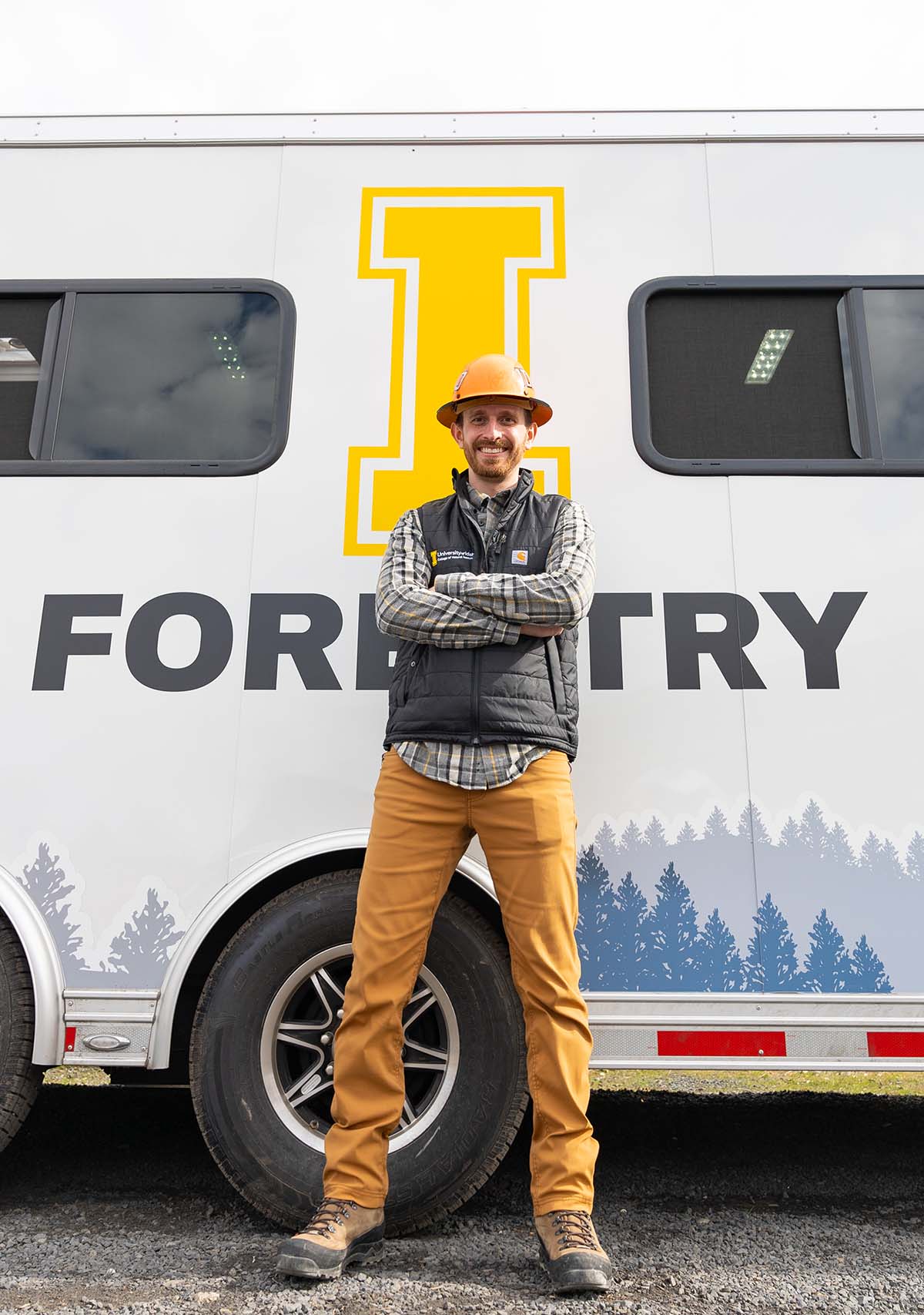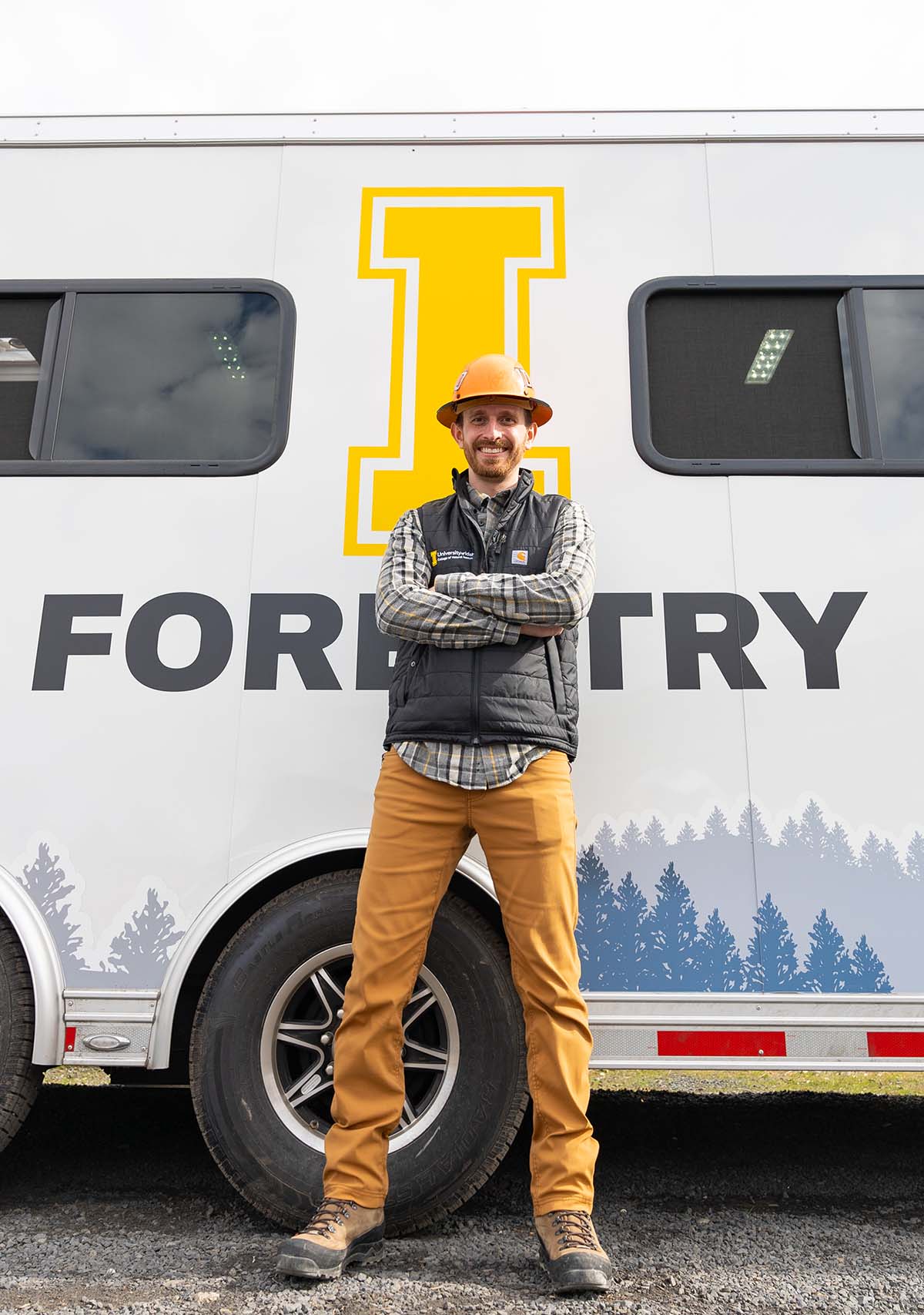Trees to Framing Timbers
Teacher's Logging Ties Translate into Real World Learning for Forestry Students
Article by Ralph Bartholdt, University Communications.
Photos by Rio Spiering, University Visual Productions.
A crane-like machine on a forest road revs its engine as cables whir on large steel drums and grapples like giant pincers lift logs into the air.
The fir logs are whisked from a mountainside to the road where the felled trees are cut into lengths and loaded onto logging trucks.
Played out almost daily in the forests of the Pacific Northwest, the scene belongs to an Idaho timber harvesting operation, and it is among the first steps in a system that turns trees into dimensional lumber.
Ryer Becker knows the procedure well.
A post doctorate who teaches students about logging methods and equipment, Becker spends much of his free time “in the woods” — a term used by loggers to describe where they work.
When he isn’t in University of Idaho classrooms, Becker is among contractors and loggers, trudging steep hillsides to capture drone, video and still footage of logging operations and equipment. His social media posts tell the stories, he says, that many young people — despite growing up in the forested regions of Idaho where the timber industry once provided a large portion of the jobs — have not heard before.
“A lot of the young people don’t know that the economy of North Idaho once relied on harvesting trees,” Becker said. “And they don’t know that these jobs are still out there, and they provide a good income for people who have the skills.”
Teaching students the skills to work in the industry, which is mostly mechanized and rapidly changing, is among Becker’s missions.
He regularly travels to high schools, trade shows and forestry seminars toting a trailer behind his pickup truck. Inside are a variety of equipment simulators — complete with screens, joy sticks and foot pedals — that participants use to learn how to operate cutting -edge equipment used in the timber industry.
In steep, challenging terrain, cable systems have historically been used to move felled trees to the landing. With advances in technology, it is now common to find winch-assisted equipment working directly alongside cable operations. After trees are moved to the landing, they are processed into logs destined for the mill. Grapple skidders, like the one seen in the second portion of this clip, are the most common ground-based method for moving felled trees to the landing in Idaho.
As part of U of I’s two and four-year forest operations curriculum Becker teaches students the ins and outs of a logging operations, how to manage stands of timber and efficiently administrate a timber management business.
Becker, who when he’s in the woods, dons a bright orange hard hat with a University of Idaho logo, did not grow up near Northwest logging operations.
His grandfather was a naturalist in northwestern New York who taught a younger Becker a love for the forest, and his dad was an engineer which sparked an interest in an engineering pathway.
“I tried engineering school, but didn’t like it,” Becker said. “I wanted to be outside.” He earned a degree in forestry and headed west.
At U of I his interest led him to the Experimental Forest, the 10,000-plus acre outdoor classroom of the College of Natural Resources, which is an actively managed, timber-producing forestland. It’s also used for research in silviculture, wildlife management and wildland and prescribed fire applications in addition to its many recreational opportunities.
Ryer Becker, Ph.D.
Assistant Research Professor, Forest Operations and Products Manufacturing Extension Specialist
After earning his doctorate he stayed on as research faculty teaching students about cable logging, forest roads, GPS applications in forestry and logging operations.
In his campus office books on logging history share space with tree cones and antiquated hand tools that were once part of the logging trade.
“People think logging is archaic work that no longer has a place in our society,” Becker says, but the idea that logging is outdated is a misconception.
“It plays such an important role in sustainable forest management,” he said. “Everything from the growth and cultivation of trees, fire resilience, a tree stands’ resistance to fire, to capturing the resource, storing carbon and providing these materials that we use every day from the food to the construction industry. Logging operations are really where the rubber meets the road.”
A lot of the young people don’t know that the economy of North Idaho once relied on harvesting trees. Ryer Becker, CNR research faculty

“The new technology of the timber industry is evolving so rapidly,” he said.
Lidar, which uses aircraft and drones to provide forest imagery, and GPS systems that equipment operators can use to locate fellow workers and machines, are becoming more operational.
Even Becker’s teaching methods are state of the art. To explain how an operation works, diagrams in books often give way to pictures and drone footage.
The Facebook posts where Becker shows off his work include a bonus. They introduce students to regional logging contractors and future employers.
“Many thanks to Nelson Brothers Timber Management for having me out once again. It’s always a pleasure spending the day out with their crew,” Becker said in a Facebook post that shows a type of logging machine at work near the Nelson Brothers home base at St. Maries.
The St. Maries outfit is one of a dozen Idaho contractors Becker regularly visits to gather footage and material for students.
The median age of loggers in Idaho is around 55 years old, Becker said.
“We need to bring that age down,” he said. “An aging workforce and technologically advancing industry is in big need for more young, skilled workers.”
One of the best things about the job, Becker says:
“You’re working in the most beautiful places in the state.”
Published April 2024.








